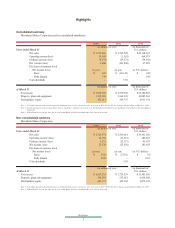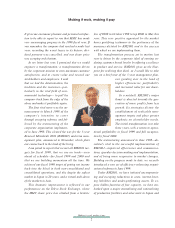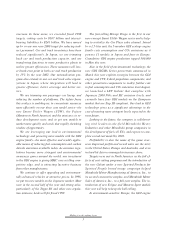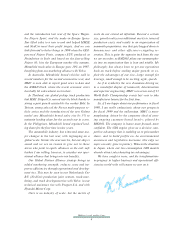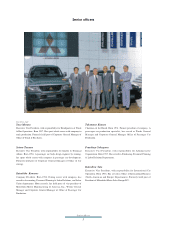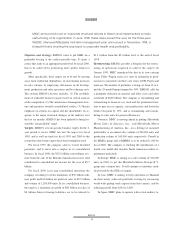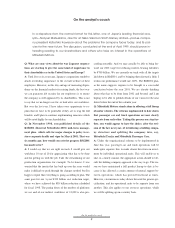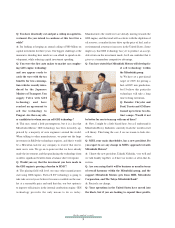Mitsubishi 1999 Annual Report Download - page 12
Download and view the complete annual report
Please find page 12 of the 1999 Mitsubishi annual report below. You can navigate through the pages in the report by either clicking on the pages listed below, or by using the keyword search tool below to find specific information within the annual report.
On the analyst's couch
10
your next challenge would seem to be the way you go
about putting a SUV model on the market. Do you have
plans to build a SUV locally?
A: Yes, I believe it is important that we introduce a new mod-
el which will become a solid revenue earner for us. The
Eclipse makes money, but that particular segment is shrinking
in size and so we must look carefully at what will be the next
growth segment. We have to go ahead on the basis of a well-
researched and thought-out business plan, considering such
factors as how much the SUV market will
grow, and how we can adjust to such
growth from both the production and mar-
keting aspects.
Q: Turning to Europe. Mitsubishi
Motors has recently increased its holding
in NedCar and currently shares manage-
ment with Volvo on a 50-50 basis. Now
that Volvo has been acquired by Ford,
what form will the management of
NedCar take?
A: With the change of control that has occurred, this is obvi-
ously something we are going to have to discuss with Ford.
The current arrangement works well both for Volvo and for
ourselves, so I do not see any drastic changes being made for
the time being. The question is what to do about the next mod-
el. If we are unable to share a common floor, as we have so
far, then we may have to reconsider the relative merits of the
arrangement, and also the question of its implementation. This
is a matter on which we must make a decision in the near fu-
ture.
Q: Is there any possibility of Volvo using a Ford platform,
and for NedCar to make the necessary adjustment to its
line to accommodate it?
A: Certainly, that possibility exists; as one of several options.
Q: The auto market in Asia is very depressed at the mo-
ment but this situation is not expected to continue for ever.
What steps are you planning and what timeframe are you
looking at in preparation for a recovery?
A: The situation varies considerably from country to country,
but I believe that Indonesia offers the greatest potential. The
key lies in the general election slated for June. With the stable
support of the people, the government will be able to formu-
late and implement its policies with confidence for a period of
five years and this will encourage a fast recovery.
Q: Were you anticipating this when you launched the
Kuda strategic model for the Asian market in March?
A: We actually delayed the introduction of the Kuda for a
year, so I'm hoping that the market will now
recover and that we will see an explosive
increase in demand. The Kuda is a very well
finished automobile. It is a new type of car;
one that looks set to become very popular.
Our dealers are swamped with orders and
are crying out for shipments to fill them.
We expect to see the strongest recovery in
the region this year in Indonesia. The Thai
market is also showing signs of recovery,
but since exports are our real money earner
in Thailand, any recovery in domestic demand will be a bonus
for us.
Q: Looking at the truck market in Japan, fiscal 1998 saw
overall demand at its lowest level for 30 years, and the fi-
nancial markets do not expect to see any substantial recov-
ery this year. How do you see the situation?
A: I have to agree with you, totally. Judging from the size of
the haulage market, there will have to be a reduction in the
combined capacity of Japan's four truck makers to bring down
the break–even point, even before we start thinking about a re-
covery. I don't know what the others are going to do, but we
have already cut capacity by about 10%.
Q: So, what you're saying is that in the Japanese truck
market you are aiming to break–even at a volume of
80,000 or so?
A: That's about the size of it. Given the size of the market to-
day, the only way to make any money is to bring down the
break–even point. We are working to improve our operational



